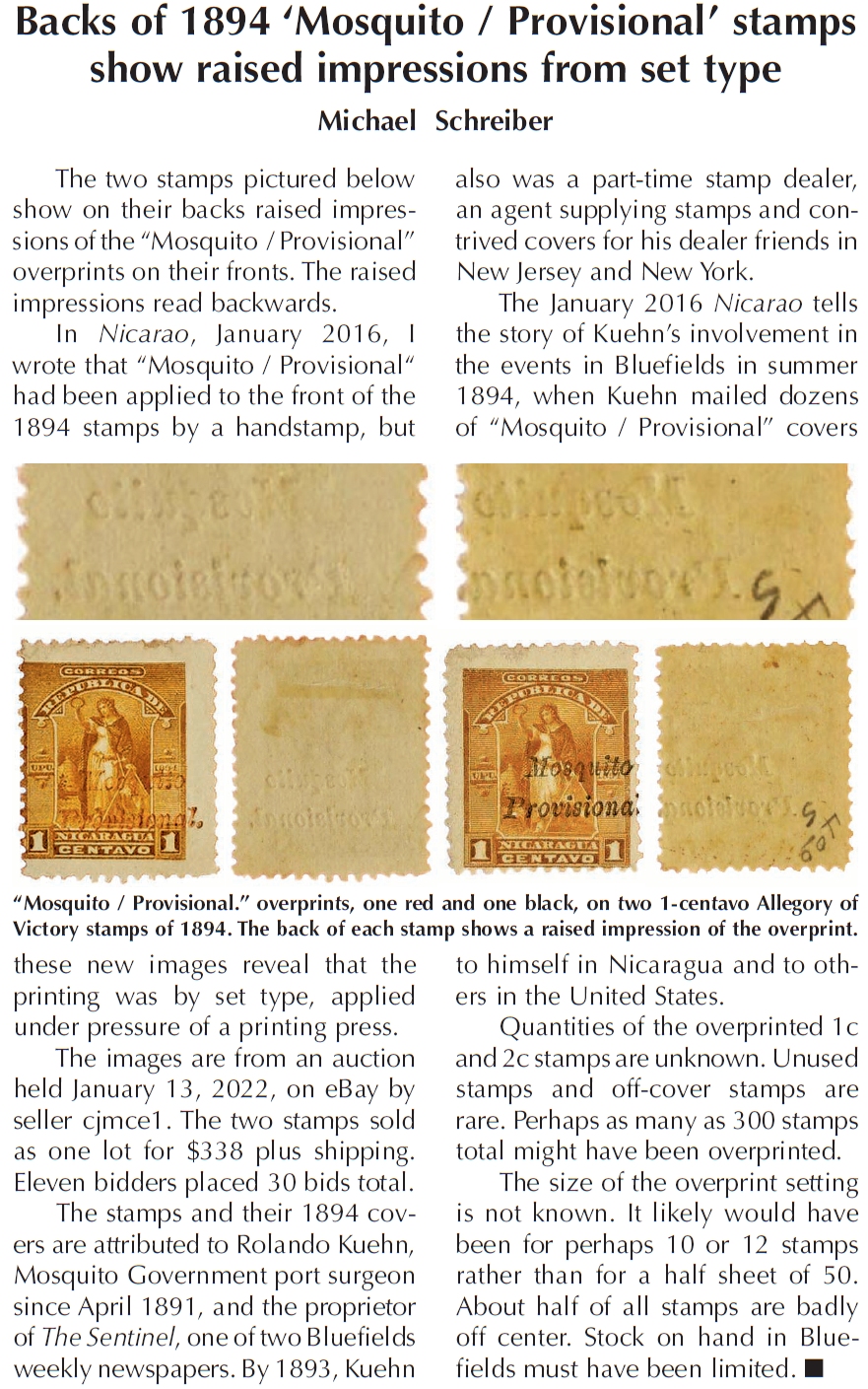Page about private issue
05.09.2020 MSCHREIBER
(updated – April 2022)
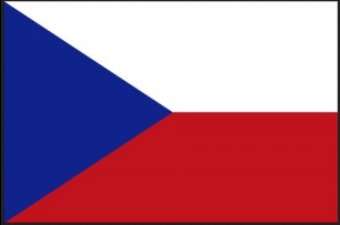
Michael Schreiber
In July 1894 in Bluefields, Nicaragua, opportunist Rolando Kuehn created covers bearing stamps of the 1894 issue handstamped “Mosquito / Provisional.” It is a certainty that Kuehn addressed the covers. It is not known if he created the handstamped adhesives, but the evidence says that he almost certainly did.
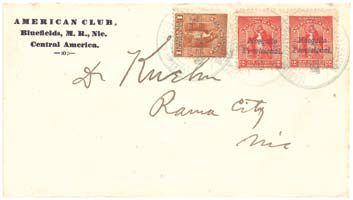
 Figure 1. Cover addressed by Rolando Kuehn to himself at Rama City, located up the Rio Escondido and a 50-mile trip west from Bluefields. The cover is postmarked July 16, 1894, at Bluefields. It bears no backstamp or other markings on the front or the back.
Figure 1. Cover addressed by Rolando Kuehn to himself at Rama City, located up the Rio Escondido and a 50-mile trip west from Bluefields. The cover is postmarked July 16, 1894, at Bluefields. It bears no backstamp or other markings on the front or the back.
Kuehn (1859-1934) was in Nicaragua from at least June 1889 until sometime in early 1903. He was an American physician, born and educated in Philadelphia. Since April 1, 1891, he had been working in Bluefields as port surgeon, but he had many interests in addition to medicine.
In 1892, Kuehn had begun printing and publishing The Sentinel newspaper. Previously he had been interested in mining, and to some degree he explored opportunities with a machine for peeling bananas and with blankets made from tree bark. His great success came in supplying postage stamps and covers for dealers and for himself to sell in the United States. [1] Figure 1 pictures both sides of a typical “Mosquito / Provisional.” cover addressed by Kuehn to himself at Rama City. The back bears no Rama backstamp or other marking. Some similar covers, however, bear setoff red ink that appears to match the red ink used for the red “Mosquito / Provisional.” handstamps.
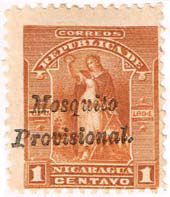 |  |
Figure 2. Rare unused examples of “Mosquito / Provisional.” handstamps in black on 1-centavo and 2-centavo stamps of 1894.
 | 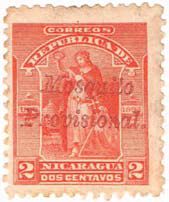 |
Figure 3. Rare unused examples of “Mosquito / Provisional.” handstamps in red on 1-centavo and 2-centavo stamps of 1894.
Figure 2 and Figure 3 on page 3 picture the four “Mosquito / Provisional.” stamps: red or black handstamps on 1-centavo yellow brown and 2-centavo vermilion Allegory of Victory stamps of 1894.
Nicaragua occupies Bluefields
The details of the February 1894 takeover of the Mosquito Reserve by José Santos Zelaya and the revolt of early July 1894 provide important context for the “Mosquito / Provisional.” stamps and covers. [2]
In the revolution of July 1893, the liberals took power in Nicaragua, ousting a provisional government. New President José Santos Zelaya soon moved to assert control over eastern Nicaragua, including Bluefields. Map 1 and Map 2 on page 4 highlight locations mentioned in the following narrative. [3]
 Map 1. Detail of a map of eastern Nicaragua from Pearl City south to Bluefields, west to Rama and south to San Juan del Norte.
Map 1. Detail of a map of eastern Nicaragua from Pearl City south to Bluefields, west to Rama and south to San Juan del Norte.

Map 2. The Mosquito Reservation (hashed black line with yellow highlight) stretched from Bragmans Bluff to the Rio Rama.
Nicaragua had only nominal control in eastern Nicaragua. Britons, Jamaicans and Americans had economic control in the region under a token Miskito Indian government over what was called the Mosquito Reserve. The Mosquito Reserve regional government operated under provisions of the 1860 Treaty of Managua and the 1881 arbitration award by Austrian Emperor Franz Joseph I. The award decided various disputes in favor of the Mosquito Reserve.
Jamaicans J.W. Cuthbert and John D. Thomas were the primary administrators of the Mosquito Reserve under Hereditary Chief Robert Henry Clarence, who became king in 1890 at age 16 or 17.
In fall 1893, Zelaya sent Gen. Carlos A. Lacayo to Bluefields as his special commissioner to the eastern province, which since 1882 had developed economically through investments by Americans in banana and other plantations and timber harvesting.
Lacayo arrived November 2, 1893, along with Gen. Rigoberto Cabezas as his inspector general.
In December 1893, Nicaragua and Honduras went to war. To look out for its interests, the United States ordered the steam sloop-of-war USS Kearsarge (of Civil War fame) to Bluefields, but the ship, after leaving Haiti on January 20, ran aground February 2 on a reef off Roncador Cay and was declared lost.
In place of Kearsarge, the protected cruiser USS San Francisco (C-5), then at Brazil, was ordered to Bluefields. It did not arrive until April 26. The armored cruiser USS New York (ACR-2) also called at Bluefields on its way back from Brazil to New York harbor. The protected cruiser USS Columbia (C-12) also called.
Under the ruse of a threatened invasion from Honduras, nearly 200 Nicaraguan troops had arrived in Bluefields in December 1893. This caused concern among the Mosquito government and uneasiness among the residents until the troops left on December 15 for Puerto Cabezas. More troops arrived in January 1894, but on January 15 they also went north.
Zelaya then sent 126 more troops to Bluefields. These troops arrived February 11, 1894, and occupied El Bluff, and on February 12 they occupied Bluefields. Special commissioner Lacayo declared martial law in Bluefields, and Zelaya installed Cabezas as inspector general for the entire Atlantic Coast region. Chief Clarence and his advisors withdrew to Pearl Lagoon.
Cabezas voided ongoing concessions and contracts and began to collect export taxes. Foreign businesses in Bluefields and other towns were required to use Spanish in official transactions.
American, British, and other merchants in Bluefields and in the reserve feared that their banana, timber, and other investments would be appropriated. They asked for help through local consuls who cabled the bad news home to their governments, sending messages by boat to the telegraph cable stations at Greytown (San Juan del Norte) or Puerto Limón, Costa Rica. [4] First to arrive to protect business interests and keep the peace was the British ship HMS Cleopatra on February 22, arriving before the first American forces did. On March 2, Cleopatra landed an armed force of 50 at Bluefields, and martial law was lifted. HMS
Canada eventually relieved Cleopatra, and HMS Magicienne also called.
On March 4, the British consul, the captain of the Cleopatra, and Lacayo agreed to a treaty for a provisional council to govern Bluefields and the region, but the council soon fell apart. Lacayo and Cabezas appointed token replacements.
Over the next three months, Lacayo and Cabezas remained in control, but gunshots regularly rang out in the streets of Bluefields and a general lawlessness and unease prevailed under a facade of calm.
On May 21, Clarence and his advisors returned to Bluefields on Magicienne to be placed under the protection of the Nicaraguans.
The celebration of the July 4 American holiday was subdued, but Bluefields soon was in chaos.
On July 5, a dispute over unpaid wages to the mostly Jamaicans working as policemen for the provisional council boiled over. Lacayo’s soldiers beat and bayoneted some of the complaining policemen. Later that evening over many hours, a mob riddled the Government House with bullets (the building where Cabezas stayed with some of his soldiers).
On July 6, taking advantage of the uprising, Robert Henry Clarence issued a proclamation, a bulletin posted in the streets, declaring himself again the chief of the Mosquito Reserve. Mobs dragged the flag of Nicaragua through the streets. On July 7, the insurgents successfully attacked the Nicaraguan garrison at El Bluff and confiscated its guns.
Commander Charles O’Neil, captain of the USS Marblehead, arranged a cease-fire. Marblehead had arrived off Bluefields June 19. With the approval of Lacayo, O’Neil landed U.S. Marines at Bluefields on July 7 and reinforcements on July 31. The Marines stayed until August 7, and Marblehead departed August 12. A company of seamen from USS Columbia were among the reinforcements that landed July 31 and departed August 7.
Cabezas and other Nicaraguans and supporters left Bluefields July 11 for the 50-mile trip to Rama, located a few miles west of the western boundary of the reserve. As of July 11, the once-deposed Mosquito Reserve government again was in complete but tenuous control. A few days later, Kuehn began to make his “Mosquito / Provisional.” covers. [5]
Amid the turmoil of the occupation beginning in February 1894 and the July 1894 revolt, Kuehn mostly appears to have kept a low profile. In the compilation titled Foreign Relations of the United States. Nicaragua (Mosquito Territory). 1894. (U.S. Government Printing Office, Washington, D.C., 1895), Kuehn is mentioned only once, and his name is misspelled. This 209-page book includes official U.S. records of the events: mostly diplomatic cables and reports of naval commanders.
Pages 158-161 include a report to the secretary of the U.S. Navy by Commander O’Neil of the USS Marblehead, who wrote July 25 off Bluefields about the events of early July: “On that evening [July 5] not only were Jamaica negroes out in force, but some white men, and they were in search of one Dr. Kuhun [Rolando Kuehn] and one Higley, two Americans who had been identified for some time with the Nicaraguan commissioner [Lacayo], and who were very unpopular, and had they found these two men that night it would probably have fared badly with them.” [6]
In other words, Kuehn had joined the camp of the occupying Nicaraguans even though his ongoing employment as port surgeon had begun in April 1891 under the government of the Mosquito Reserve.
The 1894 stamps handstamped “Mosquito / Provisional.” were meant to acknowledge the provisional council set up by the occupying Nicaraguans. It is ironic that the stamps were applied to covers and postmarked almost exclusively during the four weeks that Clarence and the Mosquito Reserve government again were in control after the revolt of July 5-7.
After the revolt, Zelaya sent an expeditionary army from Managua via San Juan del Norte to Bluefields. Government officials accompanied the army, including José Madriz, minister of foreign affairs and special commissioner to the Mosquito Reserve.
Five hundred Nicaraguan troops arrived at Bluefields on August 3 and recaptured El Bluff on August 5. On August 7, U.S. forces returned to the U.S. ships, and by August 16, Zelaya’s forces again had full but informal control in Bluefields.
In November 1894, delegates from the native tribes in the reserve convened and declared on November 20 for incorporation with Nicaragua. Nicaragua then formally took control of the reserve, and the convention renamed it the Department of Zelaya, effective December 28, 1894. The Nicaraguan government took control of the flow of money and goods through Bluefields, and it granted monopolies for production and sales, including making grants to Americans.
Red ink setoff on some covers
Figure 4 pictures both sides of a “Mosquito / Provisional.” cover with red ink setoff on the back. The cover is postmarked July 16, 1894, according to study group member Jean Pierre Amselle, who provided the Figure 4 image and the great majority of the images pictured in Figure 2 through Figure 29.


Figure 4. “Mosquito / Provisional.” cover postmarked July 16, 1894, with red setoff of “Mosquito / Provisional.” on the back.
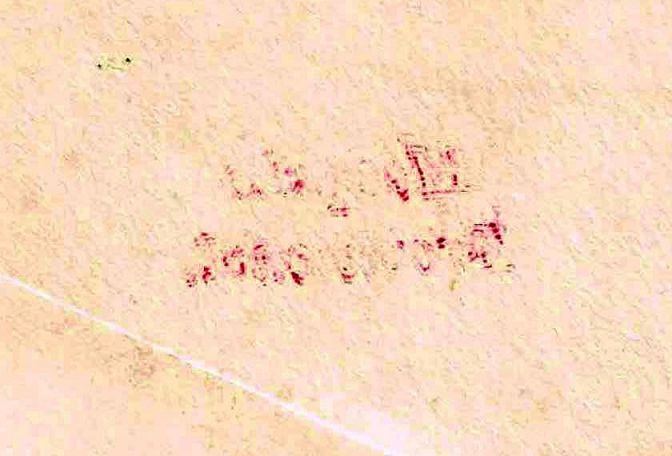
Figure 5. Detail of red ink setoff on the back of the Figure 4 cover, possibly from a still-wet handstamp on a stamp on another cover.
Figure 5 pictures a detail of the setoff, which appears to include partial doubling. The doubling, if it is doubling, implies that the cover was placed by hand on top of a similar cover bearing a stamp with the red ink still wet. The placement of the top cover seems to have resulted in a light kiss print before the top cover came to rest and absorbed more red ink. The position of the setoff is where it would be expected to be if placed on top of a similar cover.
Why was the red ink still wet? The logical inference is that the red ink could have been, and seems to have been, applied to the stamp after the stamp was affixed to the cover. This was the belief of Fabio Vaccarezza writing in January 2003 in his description of the red setoff phenomenon on a cover in his possession. In a later conversation with the author (Schreiber), Kuehn aficionado Bill Welch noted the same phenomenon and the same possible explanation of the red handstamp being applied to the stamp after the stamp had been affixed to the cover. The author is not aware of any setoff of a black “Mosquito / Provisional.” handstamp on a 2-centavo stamp or any mention of black setoff in the literature.

 Figure 6. Another “Mosquito / Provisional.” cover postmarked July 16, 1894, with light red setoff of “Mosquito / Provisional.”
Figure 6. Another “Mosquito / Provisional.” cover postmarked July 16, 1894, with light red setoff of “Mosquito / Provisional.” Figure 7. Detail of red ink setoff on the back of the Figure 6 cover.
Figure 7. Detail of red ink setoff on the back of the Figure 6 cover.
Figure 6 pictures both sides of another “Mosquito / Provisional.” cover with red ink setoff on the back. The cover is postmarked July 16, 1894, according to Amselle. Figure 7 shows a detail of the setoff, which is indistinct but which appears to be a mirror image of a “Mosquito / Provisional.” handstamp.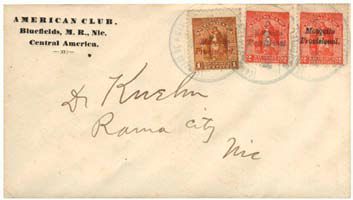 Figure 8. Another July 16, 1894, cover with setoff red ink on the back. The setoff ink is not pictured with this article.
Figure 8. Another July 16, 1894, cover with setoff red ink on the back. The setoff ink is not pictured with this article.
In articles published in 2002 and 2003, both Vaccarezza and Wolfgang Baldus pictured the “Mosquito / Provisional.” cover shown here as Figure 8, another American Club envelope addressed by Kuehn to himself. Vaccarezza also pictured part of the back of this cover, showing setoff of the red ink of “Mosquito / Provisional.” as a blurry mirror image. He claimed that the setoff indicated that the “Mosquito / Provisional.” stamps are fake [7] (He meant that the “Mosquito / Provisional.” handstamp is bogus, or that it never existed as a genuine official marking).
‘Mosquito / Provisional.’ handstamps
The black handstamps on the 2-centavo stamps affixed to the Figure 8 cover are interesting in that one black handstamp is light black (almost gray) and that the other is heavy black. The two 2-centavo stamps have nearly the same centering, so it is logical to assume that they are from the same sheet or block. The two black handstamps are applied in different positions relative to the vignette, more evidence that they were applied by a handstamp and not over-printed on a press using a multiple setting.
 Figure 9. Fourteen stamps on piece postmarked July 15, 1894. Top row: horizontal pair and strip of five. Bottom row: single and two strips of three. The colored lines underscore the word “Provisional.” on each stamp. The positions of the handstamps vary slightly, but on the strip of three underscored in white, one handstamp rises left to right while the other two fall slightly left to right.
Figure 9. Fourteen stamps on piece postmarked July 15, 1894. Top row: horizontal pair and strip of five. Bottom row: single and two strips of three. The colored lines underscore the word “Provisional.” on each stamp. The positions of the handstamps vary slightly, but on the strip of three underscored in white, one handstamp rises left to right while the other two fall slightly left to right.
Figure 9 pictures a piece bearing 14 examples of the “Mosquito / Provisional.” handstamp on 1-centavo stamps. The stamps include in the top row a horizontal pair partly separated and slightly splayed at the bottom and a strip of five, and in the bottom row a single and two strips of three.
The positions of the handstamps vary slightly on the single and most of the multiples, as shown in Figure 9 by the colored lines that underscore the word “Provisional.” on each stamp. In the strip of three at the right of the bottom row, underscored in white, the first handstamp is struck on a rising diagonal, while the other two are struck on falling diagonals, indicative of handstamping.
 Figure 10. Ten 1-centavo singles handstamped in red “Mosquito/Provisional.” The stamps are on a cover postmarked at Bluefields July 19, 1894. Each circle is centered on the bowl of the “P” of “Provisional.”
Figure 10. Ten 1-centavo singles handstamped in red “Mosquito/Provisional.” The stamps are on a cover postmarked at Bluefields July 19, 1894. Each circle is centered on the bowl of the “P” of “Provisional.”
Kuehn addressed the cover pictured in Figure 10 to the “Insurance Department / American Cotton Oil Co. / 29 Broadway / New York City / usa.” The handwriting is unmistakable, based on messages and signatures Kuehn wrote on mailed postal cards in the early 1890s. The recipient probably was a stamp friend of Kuehn.
The 10 single stamps affixed to the Figure 10 cover all are centered low, some to the left and some the right, suggesting that the stamps could be and probably are from the same sheet or block. The positions of the handstamps vary, as the red circles demonstrate. Each circle is centered on the bowl of each “P” of “Provisional.”
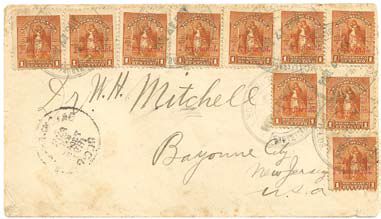 Figure 11. Ten 1-centavo singles handstamped in red “Mosquito / Provisional.” The stamps are on a cover postmarked at Bluefields August 17, 1894, and addressed by Kuehn. Some of the stamps are positioned as if they are horizontal pairs, but they are not pairs. The position of each handstamp varies slightly relative to the respective printed stamp.
Figure 11. Ten 1-centavo singles handstamped in red “Mosquito / Provisional.” The stamps are on a cover postmarked at Bluefields August 17, 1894, and addressed by Kuehn. Some of the stamps are positioned as if they are horizontal pairs, but they are not pairs. The position of each handstamp varies slightly relative to the respective printed stamp.
The cover pictured in Figure 11 is addressed to William H. Mitchell, a dentist residing in Bayonne, New Jersey. Mitchell and Kuehn corresponded about stamp dealing, and Kuehn was a supplier for Mitchell. This cover is backstamped on the front.
The Figure 11 cover is the latest “Mosquito / Provisional.” cover documented. It is postmarked August 17, 1894. This is two weeks after the arrival of the Nicaraguan troops that retook El Bluff and Bluefields, so the cover represents a use under the government for which the stamps are named, even though the use was after the revolt of July 5-7.
The 10 stamps on the Figure 11 cover are centered similar to the stamps on the Figure 10 cover, low and to the left or right. The positions of the handstamps vary relative to the stamp design. Most handstamps are applied on a slight rising diagonal, but two are on a falling diagonal. The handstamp on the single stamp in the third row appears to be partly doubled.
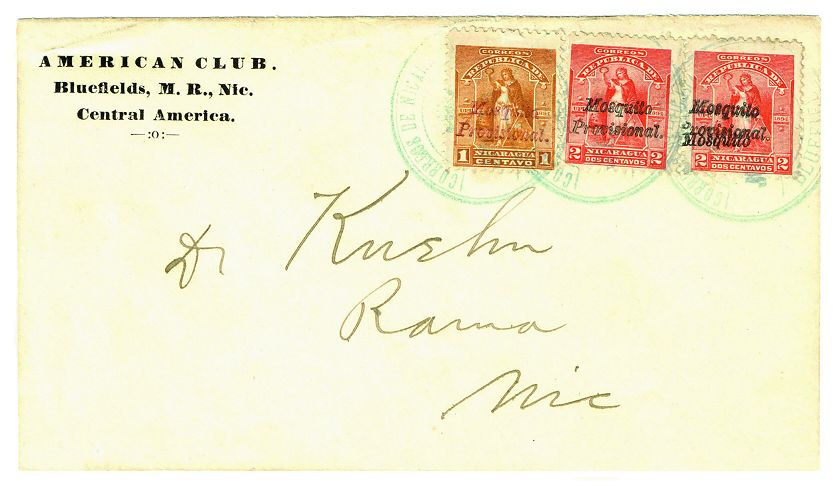 Figure 12. One of the 2-centavo stamps affixed to this cover bears a second imprint of “Mosquito” without “Provisional.” See below.
Figure 12. One of the 2-centavo stamps affixed to this cover bears a second imprint of “Mosquito” without “Provisional.” See below.
 Red “Mosquito / Provisional.” Red “Mosquito / Provisional.” |  Black “Mosquito / Provisional.” Black “Mosquito / Provisional.” |  Double black “Mosquito” Double black “Mosquito” |
Figure 12 pictures another “Mosquito / Provisional.” cover postmarked in July 1894. The franking includes one 2-centavo “Mosquito / Provisional.” stamp bearing a second strike of only the word “Mosquito.” It is possible that the extra “Mosquito” was applied first.
The three stamps on the cover are pictured below Figure 12. In each handstamp impression, the letters of “Mosquito / Provisional.” appear outlined, with the ink heavy around the edges of each letter and less intense within the edges. This is a characteristic of an impression made by raised type, probably loose type clamped tightly in a small forme that could be held and manipulated with the fingers of one hand.
The letters of the handstamps impressed on the Figure 2 and Figure 3 unused stamps exhibit the same heavy edges and less intense interiors.
The evidence points to Kuehn
Kuehn’s weekly Bluefields newspaper The Sentinel could be the source for the type used for the handstamp, but it is not the only possibility. The rival Bluefields weekly The Messenger also could be the source, but other evidence points sharply to Kuehn. [8] Kuehn addressed all of the documented covers. They all are positively written in his hand. No covers mailed by anyone else are documented.
Kuehn addressed the great majority of the documented covers to himself. There is no documentation that any of the covers addressed to Kuehn are backstamped. At least some of the covers Kuehn mailed to other persons are backstamped.
In 1994, Welch reported in his article “The Bones of Rolando Kuehn” that an investigation by Scott Stamp and Coin Company into the 1894 “Mosquito / Provisional.” stamps was published in London in The Philatelic Record and Stamp News for April 1898.
According to the investigation, the overprinted stamps were created by a Nicaraguan government commissioner (“General A.L.”) and an “American physician” to sell in foreign countries. The general used his influence to have covers (“a few hundred at the utmost”) passed through the post office. The unsigned article was attributed to “a disinterested party.” [9]
“A.L.” could refer to Gen. Carlos A. Lacayo, the Nicaraguan provisional government commissioner, and the “American physician” could be Kuehn. As noted in previous paragraphs, Commander O’Neil of USS Marblehead stated in a report of July 25, 1894, to the Navy secretary that Kuehn “had been identified for some time with the Nicaraguan commissioner.”
Welch wrote: “Kuehn almost certainly created the Mosquito Provisional stamps and covers. He had motive, means, and opportunity.” [10]
The role of William H. Mitchell
Hundreds of covers exist mailed from Kuehn to William H. Mitchell. There is no census, and the actual count could be more than 500.
The earliest item between them is a Kuehn mailing of July 17, 1893, referred to in the message on a postal card sent from Mitchell to Kuehn at Bluefields and backstamped there September 5, 1893.
Another documented item is a postal card from Mitchell to Kuehn postmarked at Bayonne, New Jersey, March 14, 1894. The messages on both cards concern stamps and stamp collecting.
Kuehn sent at least one cover to Mitchell in 1894 bearing only normal stamps. It is postmarked at Bluefields July 22, 1894, and it bears four 5-centavo stamps, for double the 10-centavo foreign letter rate.
Mitchell publicly promoted the collecting of local stamps, but he went far beyond mere promotion. He is credited with creating the Blizzard Mail local stamp for supposed use on mail privately carried across the Hudson River from Bayonne to the New York City post office in March 1888.
This was immediately after the March 12-14 Great Blizzard that halted rail, telegraph and road traffic for up to a week. The “5 CENT” Blizzard Mail stamp is Scott 163L1. The Scott catalog values it only unused.
Welch also located a Mitchell advertisement for “Mosquito / Provisional.” stamps in Mekeel’s Weekly Stamp News of July 25, 1895. The ad said: “Seebeck did not issue these Provisionals, and I have been fortunate enough to secure a few that I will dispose of at the following prices: One cent, $1.00 each. Two cent, $5.00 each. These stamps I will guarantee to have done postal duty. I also have a few unused at the same price. W.H. Mitchell, 33 W 8th St., Bayonne, N.J.” [11]
On October 20, 1899, before the Philatelic Section of the Brooklyn Institute of Arts and Sciences, Mitchell read his paper on the “Mosquito / Provisional.” stamps. In it he cited the Provincial Council minutes of early June 1894 as the authority for the provisional stamps. His paper was printed in the February 8, 15, and 22, 1900, issues of Mekeel’s Weekly Stamp News. [12]
Was Mitchell telling the truth?
Are the stamps legitimate or bogus?
It is plausible that the provisional council could have authorized such a stamp issue, but the council almost certainly would not have done so without the prodding of Kuehn and the concurrence of Lacayo. They were associates, as Commander O’Neil of USS Marblehead stated: Kuehn had been “identified for some time with the Nicaraguan government.”
The documented covers all bear 1-centavo stamps handstamped in red and 2-centavo stamps handstamped in black.
Also documented are unused 1-centavo stamps handstamped in black and unused 2-centavo stamps handstamped in red, but there are no documented covers bearing these combinations. Why not?
If the stamp issue is legitimate or possibly even semi-legitimate, why are all the documented covers from Kuehn and from no other person? This is the most unbelievable aspect of the stamps and covers.
The stamps could have been authorized by a compliant provisional council, and Lacayo in conspiracy with Kuehn could have authorized Kuehn to produce them. Kuehn could have dawdled, and the events of the revolt could have overtaken him before he finally made the stamps and the covers while the opportunity existed.
Many of the covers addressed to Kuehn seem hurriedly made, with stamps affixed partly on top of the manuscript address. Nearly all of the original stamps are poorly centered, suggesting that Kuehn or someone had to use what stamps were available.
The covers bearing setoff ink imply that the handstamp could have been added to at least some stamps after those stamps were affixed to a cover, meaning the stamps probably would be bogus. If it is true that some handstamps were applied to on-cover stamps, then Kuehn or someone else was careful that any added handstamp was struck completely on the stamp. No documented cover has the handstamp partly on the stamp and partly on the envelope.
There is no documented inverted handstamp, but one stamp is documented with only “Mosquito” plus a normal handstamp, and one stamp is documented with only “Provisional.” Stamps with misprinted handstamps in general are infrequent.
If Kuehn created the “Mosquito / Provisional.” stamps, he might not have wanted to push his luck by making an invert or another collectible variety, such as handstamps applied vertically, either reading up or reading down.
For the covers, perhaps Kuehn might not have wanted to overstep a possible official decision to have the red overprint only on the 1-centavo stamp and the black overprint only on the 2-centavo stamp.
Too many unknowns remain. Until a cover or multiple covers from senders other than Kuehn come to light, the “Mosquito / Provisional.” stamps should be regarded as bogus, even though some covers transited normally through the mailstream to the United States.
Also needed for study are other cards and covers mailed from Bluefields in the period from about July 8 through about August 17, 1894. What stamps constitute their frankings, and who mailed them and to whom?
Bogus or not, the “Mosquito / Provisional.” covers and stamps are coveted items, and collectors continue to pay dearly for them.
 Figure 13. Five 1-centavo stamps pay the domestic letter rate on this Kuehn cover to Greytown postmarked July 15, 1894, at Bluefields.
Figure 13. Five 1-centavo stamps pay the domestic letter rate on this Kuehn cover to Greytown postmarked July 15, 1894, at Bluefields.
 Figure 14. Five 1-centavo stamps pay the domestic letter rate on this Kuehn cover to Cabo Gracias postmarked July 15, 1894, at Bluefields.
Figure 14. Five 1-centavo stamps pay the domestic letter rate on this Kuehn cover to Cabo Gracias postmarked July 15, 1894, at Bluefields.
 Figure 15. Five added 1-centavo stamps rate this 5-centavo envelope of 1894 up to the foreign letter rate. The postmark date is July ?? 1894.
Figure 15. Five added 1-centavo stamps rate this 5-centavo envelope of 1894 up to the foreign letter rate. The postmark date is July ?? 1894.
Figure 13 through Figure 27 picture other “Mosquito / Provisional.” covers mailed by Kuehn. All are postmarked at Bluefields.
All of the adhesives are red handstamps on 1-centavo stamps of 1894 or black handstamps on 2-centavo stamps of 1894.
The Figure 13, Figure 14 and Figure 15 covers are correctly rated for the domestic letter rate or the foreign letter rate. Kuehn almost always used correct postage on his mailings.
The Figure 15 cover is a 5-centavo envelope of 1894 with five added 1-centavo stamps. Kuehn mailed a similar envelope to the Insurance Department, American Cotton Oil Co., 29 Broadway, New York City, postmark unclear but backstamped July 29 at New Orleans and July 31 at New York City. [13]
The Figure 10 cover also is to the Insurance Department of the American Cotton Oil Co.
 Figure 16. Postmarked July 16, 1894. Red on 1c. Black on 2c.
Figure 16. Postmarked July 16, 1894. Red on 1c. Black on 2c.
 Figure 17. Postmarked July ?? 1894. Red on 1c. Black on 2c.
Figure 17. Postmarked July ?? 1894. Red on 1c. Black on 2c.
 Figure 18. Postmarked July ?? 1894. Pencil notation on front.
Figure 18. Postmarked July ?? 1894. Pencil notation on front.
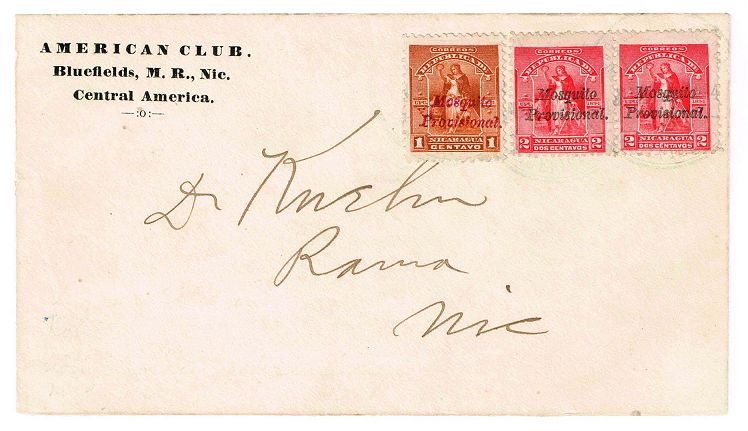 Figure 19. Postmarked July ?? 1894. Red on 1c. Black on 2c.
Figure 19. Postmarked July ?? 1894. Red on 1c. Black on 2c.
The Figure 18 cover bears the pencil notation “174 1¢ / 102 2¢.” The numerals and the cent signs strongly resemble those that Kuehn included in a tally in a letter he wrote in 1902. It is tempting to think that “174 1¢ / 102 2¢” might represent Kuehn’s summary of the “Mosquito / Provisional.” handstamped stamps he made, if he made them. [14]
 Figure 20. Postmarked July ?? 1894. Red on 1c. Black on 2c.
Figure 20. Postmarked July ?? 1894. Red on 1c. Black on 2c.
 Figure 21. Postmarked July ?? 1894. Red on 1c. Black on 2c.
Figure 21. Postmarked July ?? 1894. Red on 1c. Black on 2c.
 Figure 22. Postmarked July ?? 1894. Red on 1c. Black on 2c.
Figure 22. Postmarked July ?? 1894. Red on 1c. Black on 2c.
 Figure 23. Postmarked July ?? 1894. Red on 1c. Clipped corner.
Figure 23. Postmarked July ?? 1894. Red on 1c. Clipped corner.
The Figure 16 through Figure 25 covers are on envelopes printed with the return address of the “American Club. / Bluefields, M.R., Nic. / Central America.” Kuehn also addressed a similar American Club “Mosquito / Provisional.” cover to “Dr. Lerch / Rama / Nic.” [15] Otto Lerch was a geologist and an inspector of mines. His testimony is recorded in the U.S. documents related to the Steamer Nicaragua Affair at Bluefields August 14, 1894. Kuehn also testified, and his testimony is recorded in the documents. [16]
 24. Postmarked July ?? 1894. Stamp removed or fallen away.
24. Postmarked July ?? 1894. Stamp removed or fallen away.
 Figure 25. Postmarked July 16, 1894. Red on 1c. Black on 2c.
Figure 25. Postmarked July 16, 1894. Red on 1c. Black on 2c.
 Figure 26. Postmarked July ?? 1894. Red on 1c. Black on 2c.
Figure 26. Postmarked July ?? 1894. Red on 1c. Black on 2c. Figure 27. Postmarked July 15? 1894. Red on 1c. Black on 2c.
Figure 27. Postmarked July 15? 1894. Red on 1c. Black on 2c.
The Figure 16 through Figure 23 covers are addressed to Kuehn at “Rama / Nic.” The Figure 24 through Figure 27 covers are addressed to Kuehn at “Rama City / Nic.” or “Rama City / Nicaragua.” All are addressed in Kuehn’s hand, with the address of the Figure 27 cover being carefully written.
 Figure 28. Unused with “Provisional.” “Mosquito” missing.
Figure 28. Unused with “Provisional.” “Mosquito” missing.
Figure 28 pictures the 1-centavo stamp handstamped in red with only “Provisional.” This is the stamp mentioned on page 10. “Mosquito” is missing.
 Figure 29. Six “Mosquito / Provisional.” stamps on piece postmarked at Bluefields July 15, 1894. The stamps are in a strip of six. The postmarks on this piece and those on the larger piece pictured in Figure 9 are struck in a similar fashion, and the stamps on this piece have centering similar to many of the stamps on the Figure 9 piece.
Figure 29. Six “Mosquito / Provisional.” stamps on piece postmarked at Bluefields July 15, 1894. The stamps are in a strip of six. The postmarks on this piece and those on the larger piece pictured in Figure 9 are struck in a similar fashion, and the stamps on this piece have centering similar to many of the stamps on the Figure 9 piece.
Figure 29 shows a piece bearing a horizontal strip of six 1-centavo stamps handstamped in red. Its July 15, 1894, Bluefields postmarks are struck in a similar manner as those struck on the piece pictured in Figure 9. Its stamps also have centering similar to many of the stamps on the Figure 9 piece.
Endnotes
[1] Michael Schreiber, “A Chronology of the Life Events of Rolando Kuehn and the Covers He Created,” Nicarao, December 2014, Vol. 23, No. 5, pages 8-16.
[2] Foreign Relations of the United States. Nicaragua (Mosquito Territory). 1894. U.S. Government Printing Office, Washington, D.C., 1895, 2 pages + 207 pages. A Google book, with the entire text online, from the Harvard University Library. Search Google for this book by title and look for the entry beginning https://books.google.com/books?id=FeErAAAAYAAJ. This book is an indispensable source that includes detailed diplomatic correspondence and detailed reports of U.S. Navy officers. See also Papers Relating to the Foreign Relations of the United States, With the Annual Message of the President Transmitted to Congress December 3, 1894. U.S. Government Printing Office, Washington, D.C., 1895. Nicaragua: pages 433-480. A Google book. See also House of Representatives. 53rd Congress. 3rd Session. Ex. Doc. I, Part 1. Appendix I. Foreign Relations of the United States. Nicaragua (Mosquito Territory). 1894. U.S. Government Printing Office, Washington, D.C., 1895. “Mosquito Territory. Affairs at Bluefields”: pages 234-363. Also a Google book.
[3] Map 1 and Map 2 are reproduced from inset maps within a larger map of Central America in The Century Atlas, copyright 1897 by The Century Co. of New York City. Map 1 is a detail of Map 2, but it is not an enlargement. They are different maps. The red circles, added by the editor, highlight Bluefields and Bluefields Bay, with nearby El Bluff (The Bluff or Bluff City), located on a peninsula that shields Bluefields from the Caribbean Sea. Bluefields and El Bluff were the locations of the February 1894 occupation and the short-lived July 1894 revolt. Other circles highlight Rama, where the Nicaraguans retreated in early July 1894, and Pearl Lagoon and Pearl City, where Chief Clarence took refuge for a time. Greytown (San Juan del Norte) also is circled. Diplomatic cables from Bluefields had to be taken by ship to the telegraph station at Greytown for transmission on the telegraph line to Managua. This line often was interrupted, and when it was inoperative, cables had to be taken further south by ship to the telegraph station at Puerto Limón, Costa Rica, operated by the Tropical Trading and Transport Company. This was the banana trading company of Minor C. Keith, which in 1899 merged with Boston Fruit Company to form United Fruit Company. In both maps, a hashed black line that is highlighted in yellow defines the boundary of the Mosquito Reserve. In Map 1, between Rama and Bluefields, the town Cama is misspelled as “Camo.” It is spelled correctly in Map 2. America, located one mile north of Greytown, was the site of the canal construction company. America was to be the eastern terminus of the proposed canal that was begun but was never finished.
[4] Foreign Relations of the United States. Nicaragua (Mosquito Territory)., op. cit. Some of the documents refer to the poor condition of the telegraph line from Greytown to Managua.
[5] The author previously wrote in Nicarao, December 2014, that “Mosquito / Provisional.” covers mailed by Kuehn are documented with postmarks of July 13-24 and August 17, 1894. The July 13 date is based on the description of lot No. 1102 in the Harmer-Schau Auction Galleries sale of January 16-18, 2004. The cover in that lot is pictured in Figure 19. Its postmarks appear to be unreadable, so the postmark date of July 13 is unconfirmed. Bill Welch noted covers postmarked during July 15-22.
[6] Foreign Relations of the United States. Nicaragua (Mosquito Territory)., op. cit., Commander Charles O’Neil to Secretary of the Navy H.A Herbert, page 159.
[7] Fabio Vaccarezza, “The Mosquito Provisionals: Are They genuine or Fakes?” The Cinderella Philatelist, January 2003,pages 38-39. The article by Wolfgang Baldus is titled “The ‘Mosquito Provisional’ Overprints of Nicaragua,” The Cinderella Philatelist, October 2002, pages 185-189.
[8] The author has not been able to confirm if the office of the Moravian Church in Bluefields had a printing press and type.
[9] Bill Welch, “The Bones of Rolando Kuehn,” The American Philatelist, March 1993, Vol. 107, No. 3, page 227.
[10] Ibid.
[11] Ibid., page 226.
[12] Ibid., pages 226-227.
[13] Michael Schreiber, “Early Covers and Cards From Rolando Kuehn, 1889-1896,” Nicarao, January 1993, Vol. 3, No. 2, pages 5 and 7. Page 7 pictures the cover.
[14] Welch, “Bones,” op. cit., page 230, quotes from the letter. The letter is pictured in Nicarao, July 2015, 24:3 (15, 16-17).
[15] Schreiber, “Early Covers,” op. cit., pages 4 and 7. Page 7 pictures the “Mosquito / Provisional.” cover that Kuehn addressed to Otto Lerch.
[16] Senate Documents, 60th Congress, 1st Session. Document 93. Steamer Nicaragua. Government Printing Office, Washington, D.C., 1908. As port surgeon at Bluefields, on August 14, 1894, Kuehn played a prominent role in securing the emergency passage of American John McCafferty from Bluefields to Mobile, Alabama, aboard the Norwegian steamer Nicaragua, a fruiter carrying bananas to Mobile. Upon approaching Mobile, the ship was quarantined at Fort Morgan, Alabama, because McCafferty did not have the proper papers. Despite an effort to offload the bananas, they spoiled, and importer Orr and Laubenheimer Co. Ltd. in 1895 successfully sued the ship owner for damages. One line of testimony was that McCafferty was going to the United States to argue for government support for the American businesses in Bluefields. Another line of testimony was that McCafferty’s life was in danger. Through the legation of Sweden and Norway, the ship owner later appealed to the U.S. government for relief because the ship had saved the life of McCafferty, it was argued. Kuehn’s deposition and cross-examination December 27, 1894, in Bluefields are on pages 78-81. Otto Lerch’s deposition and cross-examination January 7, 1895, in New Orleans are on pages 85-87.
Copyright © Michael F. Schreiber, 2016
Updated in April 2022: In the Philatelic Magazine NICARAO (The Philatelic Journal of the Nicaragua Study Group) in April 2022, the author published the following news:
Publikováno pro nezávislý CZ/SK blog - www.znamkovezeme.cz
Přebírání obsahu jen s písemným souhlasem autora příspěvku !
--- Admin blogu ---

